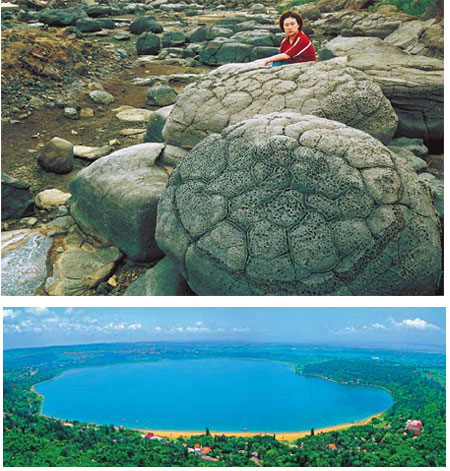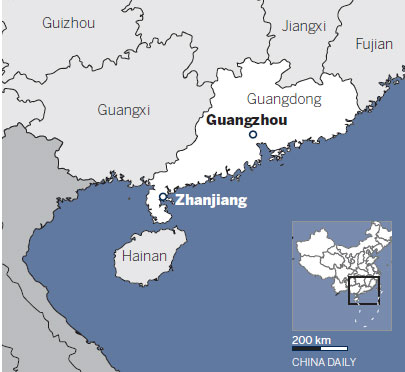A lake carved by volcanic gushes
Updated: 2012-08-16 09:35
By Raymond Zhou and Li Wenfang (China Daily)
|
||||||||
A volcanic lake in Zhanjiang not only offers respite from the hustle and bustle of modern living, but a feat in distilling millenniums of ecological change into rocks of strange formations and animals of mythical origins, write Raymond Zhou and Li Wenfang.
The word "volcano" conjures up the image of a lone peak topped with an ash-strewn bowl-shaped crevice. If there is water in that crater, it would be like an invisible acrobat holding a cup of tea.
Huguangyan is nothing like that. The 2.3-sq-km lake sits comfortably on the ground, surrounded by lush vegetation and hardly a hint of hilly terrains. However, 160,000 years ago explosions 100 times the force of the atomic bomb dropped on Nagasaki - caused by the heating of groundwater and followed by billows of smoke and magma - erupted in this place 18 km to the southwest of what is now Zhanjiang, Guangdong province.
The lake is no doubt the jewel in the crown that is the 13.6-sq-km park. At an average depth of 22 meters, it is actually a "twin lake" caused by two adjacent blasts. A stretch of an island is visible as if it were a floating device, a telltale sign of what used to divide the two craters.
Technically, it is called a maar lake, named after a similar volcano-on-the-ground landform in Germany. But the original Maar Lake is much smaller while the one in Zhanjiang is the largest of its kind on Earth. In 2004, the two became "sister lakes" for the sake of scientific research. Photos of the German lake are displayed in the Volcano Museum inside the park for easy comparison.

 'Taken 2' grabs movie box office crown
'Taken 2' grabs movie box office crown
 Rihanna's 'Diamonds' tops UK pop chart
Rihanna's 'Diamonds' tops UK pop chart
 Fans get look at vintage Rolling Stones
Fans get look at vintage Rolling Stones
 Celebrities attend Power of Women event
Celebrities attend Power of Women event
 Ang Lee breaks 'every rule' to make unlikely new Life of Pi film
Ang Lee breaks 'every rule' to make unlikely new Life of Pi film
 Rihanna almost thrown out of nightclub
Rihanna almost thrown out of nightclub
 'Dark Knight' wins weekend box office
'Dark Knight' wins weekend box office
 'Total Recall' stars gather in Beverly Hills
'Total Recall' stars gather in Beverly Hills
Most Viewed
Editor's Picks

|

|

|

|

|

|
Today's Top News
Health new priority for quake zone
Xi meets US top military officer
Japan's boats driven out of Diaoyu
China mulls online shopping legislation
Bird flu death toll rises to 22
Putin appoints new ambassador to China
Japanese ships blocked from Diaoyu Islands
Inspired by Guan, more Chinese pick up golf
US Weekly

|

|












